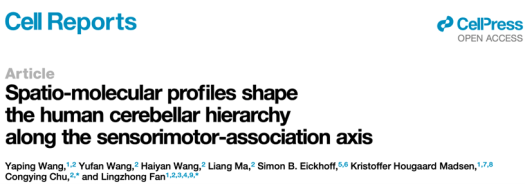Laboratory of Brain Atlas and Brain-Inspired Intelligence Reveals Spatio-Molecular Profiles Underlying the Functional Hierarchy of the Human Cerebellum
Font:【B】 【M】 【S】
Although the human cerebellum accounts for only 10% of total brain volume, it contains over 50% of the nervous system’s neurons. Beyond coordinating movement, it also influences human thought and emotion. In exploring the functional diversity of the cerebellum—particularly how it participates in and influences our cognitive and emotional processing—researchers have identified a critical axis: the sensorimotor-association (SA) axis. This axis helps explain the complexity of cerebellar functional hierarchy. However, to date, most research has focused on the generation and significance of the SA axis in the cerebral cortex, while the formation and biological basis of the SA axis in the cerebellum remain largely unexplored.

Recently, building on earlier work revealing genetic evidence for functional heterogeneity in the human cerebellum (Wang Y et al., Molecular Psychiatry, 2022), Lingzhong Fan and colleagues at the Laboratory of Brain Atlas and Brain-Inspired Intelligence, Institute of Automation, Chinese Academy of Sciences, further investigated the biological basis of the human cerebellar functional hierarchy. Their research, titled Spatio-Molecular Profiles Shape the Human Cerebellar Hierarchy Along the Sensorimotor Association Axis, was published in Cell Reports, a Cell Press journal. The study systematically integrates cross-scale multi-omics data, providing a panoramic view of the spatio-molecular profiles underlying the cerebellar SA axis—from genetic features and intermediate molecular patterns to cell types, biological processes, spatio-temporal developmental patterns, disease associations, evolutionary relevance, and cerebellar-cerebral interactions.
The study sought to answer several scientific questions: First, do significant changes in gene expression shape the cerebellar SA axis? Second, what intermediate biological principles mediate SA axis formation, and are these molecular substrates linked to cerebellar-related neurodevelopment, evolution, and neuropsychiatric disorders? Finally, given that cerebellar functional diversity mainly arises from its connections with cerebral structures, how do the cerebellum’s spatial-molecular features interact with the cerebral cortex at genetic and functional connectivity levels (Figure 1).
To address these questions, the study combined human brain transcriptomic atlases with multimodal human neuroimaging data. It found that gene expression can significantly predict the cerebellar SA axis. Using spatial autocorrelation-preserving permutation, the team identified a set of significant genes and, for the first time, introduced gene set variation analysis into brain imaging-transcriptomics association studies to uncover the spatial molecular features organizing cerebellar functional hierarchy. Interestingly, these spatial molecular features were closely associated with neuropsychiatric disorders and human brain evolution. Furthermore, interactions between the cerebellum and cerebrum at genetic and functional connectivity levels aligned with the SA axes of both structures, suggesting a basis for cerebellar-cerebral SA axis congruence.
In summary, this study provides evidence for the spatio-molecular characteristics forming the human cerebellar SA axis, revealing an organizational pattern that integrates micro- and macro-level features. By synthesizing multi-level insights into human cerebellar function, the research suggests that along the SA axis, expression of neurotransmission-related genes increases, developmental trajectories diverge, influence from evolution-related biological processes intensifies, and associations with psychiatric disorders increase.
The paper’s first author is Yaping Wang, a joint PhD student at the Institute of Automation, Chinese Academy of Sciences, and the Sino-Danish College at UCAS. The corresponding authors are Researcher Lingzhong Fan and Associate Researcher Congying Chu. Co-authors include Professor Kristoffer Hougaard Madsen from the Sino-Danish College and Technical University of Denmark (DTU), Professor Simon B. Eickhoff from the Jülich Research Center in Germany, and doctoral students Yufan Wang, Assistant Researcher Haiyan Wang, and Dr. Liang Ma from the Institute of Automation. This research was supported by the National Key R&D Program of China (Brain Science and Brain-Inspired Research) and the National Natural Science Foundation of China.
Paper link:
https://www.cell.com/cell-reports/fulltext/S2211-1247(24)00098-6
Related References:
Yaping Wang, Yufan Wang, Haiyan Wang, Liang Ma, Simon B. Eickhoff, Kristoffer Hougaard Madsen, Congying Chu*, and Lingzhong Fan*. (2024). Spatio-Molecular Profiles Shape the Human Cerebellar Hierarchy Along the Sensorimotor Association Axis, Cell Reports. 43(2), 113770, 2024. DOI: https://doi.org/10.1016/j.celrep.2024.113770
Yaping Wang#, Lin Chai#, Congying Chu*, Deying Li, Chaohong Gao, Xia Wu, Zhengyi Yang, Yu Zhang, Junhai Xu, Jens Randel Nyengaard, Simon B. Eickhoff, Bing Liu, Kristoffer Hougaard Madsen, Tianzi Jiang, and Lingzhong Fan*. (2022). Uncovering the genetic profiles underlying the intrinsic organization of the human cerebellum, Molecular Psychiatry 27, 2619–2634. DOI: https://doi.org/10.1038/s41380-022-01489-8
Copyright Institute of Automation Chinese Academy of Sciences All Rights Reserved
Address: 95 Zhongguancun East Road, 100190, BEIJING, CHINA
Email:brain-ai@ia.ac.cn